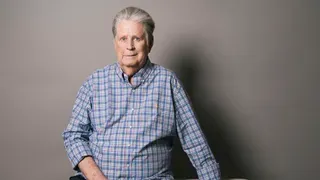June 10, 2010
John Waters - The bard of Baltimore (& SF & Provincetown)
Kevin Mark Kline READ TIME: 3 MIN.
In his new creative nonfiction book Role Models (Farrar Straus Giroux), independent film director John Waters writes about people who have inspired him in his brilliant career. He includes interviews with such figures as actress Patty McCormack (The Bad Seed), Little Richard and Marines pornographer Bobby Garcia (Camp Pendleton sex scandal), but Out There was immediately drawn to a chapter devoted to "Baltimore Heroes." OT grew up in that fabled East Coast metropolis, home of the beehive "hon," where we would see Waters out and about on the town, such as at the art-house Charles Theatre, or at the male strip club The Atlantis, which was located cheek-by-jowl with the high-security prison in East Baltimore (it's now gone, alas). To our delight, Waters talks up the old dive in his book. "I called it 'the Fudge Palace' in my movie Pecker. I always took out-of-town guests there, everybody from Gus Van Sant " to highfalutin' New York art dealers. "Even my friend Judge Elsbeth Bothe went with me one night after a long day on the bench. When I told her that 'sometimes you get teabagged by the naked dancers if you sit too close,' she didn't chicken out; she just wore a hat for protection. God, how I miss that place."
Waters, who divides his time between Baltimore, SF and Provincetown, begins his book of journalistic profiles with the following surprising admission: "I wish I were Johnny Mathis . So mainstream. So popular. So unironic, yet perfect. Effortlessly boyish at over 70 years old, with a voice that still makes all of America want to make out." Waters goes on to set up an interview with Mathis, promising to treat the subject of his sexuality gingerly. "Mr. Mathis only once responded to sexual preference questions from the press, in 1982, and he answered in a lovely way. His preference was 'a way of life one's grown accustomed to.' I had promised 'no agenda,' but I bring up this quote and compliment him on it, and he smiles and says, 'It's a normal everyday part of my life.'"
Waters is equally candid about his own private life. "The first time I went to a gay bar I was 17 years old. It was called the Hut and it was in Washington, DC. Some referred to it as the 'Chicken Hut,' and it was filled with early-1960s gay men in fluffy sweaters who cruised one another by calling table-to-table on phones provided by the bar. 'I may be queer but I ain't this,' I remember thinking."
To Out There, probably the most amazing revelation among many in the book is that despite his fame and glory as a filmmaker, Waters appears really to want to be an entertainment journalist. This reminds us of that time we interviewed Greg Louganis and realized that, despite being a world-class, Olympics gold-medalist diver, what Louganis really wanted to do was to write doggy and kitty books.
Anyway, a series of photos of Mathis is the first artwork you see when you enter Waters' art exhibit Rush, now showing at Rena Bransten Gallery in SF (77 Geary; through July 9). OT attended the opening reception last Thursday night, a big, art-loving scene in which Waters glided gracefully through the crowd and made himself open and available to fans. His photographs of scenes from classic cinema are both ironic and heartfelt; his overscaled sculptures, such as a roach motel and a giant bottle of poppers (see: exhibition name), tipped over and spilling its toxic contents, are monstrous visions of everyday objects. Worth seeing; go to www.renabranstengallery.com.





